
The Colorado potato beetle, also known as the Colorado beetle, the ten-striped spearman, the ten-lined potato beetle, or the potato bug, is a major pest of potato crops. It is about 10 mm long, with a bright yellow/orange body and five bold brown stripes along the length of each of its elytra. Native to the Rocky Mountains, it spread rapidly in potato crops across America and then Europe from 1859 onwards.
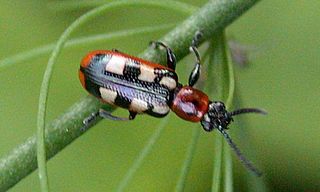
The common asparagus beetle is an important pest of asparagus crops both in Europe and in North America. Asparagus is its only food plant. The beetle is 6.0 mm to 9.5 mm long and slightly elongated. It is metallic blue-black in color with cream or yellow spots on its red-bordered elytra. The larvae are fat gray grubs with dark heads.

Xanthogaleruca luteola, commonly known as the elm-leaf beetle, is a beetle species in the family Chrysomelidae that is native to Europe but invasive in other parts of the world.

The striped flea beetle is a small flea beetle, shiny black with a greenish tinge, 1.5 to 2.5 mm long, having a wavy amber line running the length of each elytron. It is a pest of cabbage and other brassicas. The hind legs are thickened, enabling the beetle to jump like a flea when disturbed.

Otiorhynchus ovatus, the strawberry root weevil, is one of the many species in the weevil family (Curculionidae), occurring across Canada and the northern United States. The species was first described by Carl Linnaeus in his landmark 1758 10th edition of Systema Naturae. Its name comes from its affinity for strawberry plants, which form a large part of its diet. They are, however, known to feed on other plants as well. Occasionally the larvae cause serious damage to seedlings and young transplants in plantations and nurseries. It is known to be one of the major pests threatening sub-tropical strawberry farming.
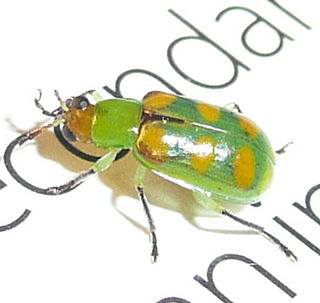
Diabrotica speciosa, also known as the cucurbit beetle and in Spanish as vaquita de San Antonio is an insect pest native to South America. Its larvae feed on the roots of crops. The cucurbit beetle is also known to transmit several viruses such as comoviruses and different mosaic viruses. This is native to South America and is now distributed in Central America and other global areas.
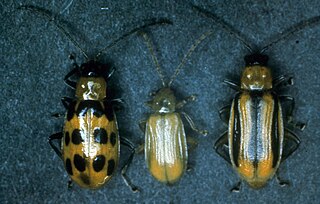
Cucumber beetle is a common name given to members of two genera of beetles, Diabrotica and Acalymma, both in the family Chrysomelidae. The adults can be found on cucurbits such as cucumbers and a variety of other plants. Many are notorious pests of agricultural crops. The larvae of several cucumber beetles are known as corn rootworms.
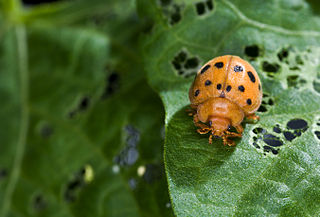
The Epilachninae are a subfamily of the family of lady beetles, the Coccinellidae, in the order Coleoptera. Superficially, they look much like other ladybirds in the larger subfamily Coccinellinae, but they differ importantly in their biology, in that the members of the subfamily are largely or completely leaf-feeding herbivores rather than being predators. Accordingly, several members of the subfamily are crop pests, and sometimes cause locally serious crop losses.

Cerotoma trifurcata is a species of beetle in the Chrysomelidae family that can be found in the Eastern and West United States.

Diabrotica balteata is a species of cucumber beetle in the family Chrysomelidae known commonly as the banded cucumber beetle. It occurs in the Americas, where its distribution extends from the United States to Colombia and Venezuela in South America. It is also present in Cuba. It is a pest of a variety of agricultural crops.

Callosobruchus chinensis is a common species of beetle found in the bean weevil subfamily, and is known to be a pest to many stored legumes. Although it is commonly known as the adzuki bean weevil it is in fact not a true weevil, belonging instead to the leaf beetle family, Chrysomelidae. Other common names include the pulse beetle, Chinese bruchid and cowpea bruchid. This species has a very similar lifestyle and habitat to Callosobruchus maculatus and their identities are often mistaken for each other. This beetle is a common pest targeting many different species of stored legumes and it is distributed across the tropical and subtropical regions of the world. C. chinensis is one of the most damaging crop pests to the stored legume industry due to their generalized legume diets and wide distribution.

Agriotes sputator is a species of click beetle, commonly known as the common click beetle. The adult beetle is brown and inconspicuous, and the larvae live in the soil and are known as wireworms. They are agricultural pests that devour the roots and underground parts of many crops and other plants.

Acanthoscelides obtectus, the bean weevil, is a species of bruchid beetle. The species was described in 1831 by Thomas Say.

Odontopus calceatus is a species of weevil which occurs in much of the eastern and southeastern United States. Its range is as far north as Massachusetts all the way south to the Gulf of Mexico, and from the Atlantic westward to the Mississippi River. Common names include yellow poplar weevil, sassafras mining weevil, tuliptree leafminer, tulip tree weevil, or the magnolia leaf miner.

Pediobius foveolatus (Crawford), is a tiny exotic parasitoid wasp that is used for biological control of Mexican bean beetle, Epilachna varivestis, an important insect pest of snap beans, lima beans, and sometimes soybeans mainly found at economic levels in the eastern United States. Pediobius foveolatus is in the family Eulophidae, and is the most successful biological control agent for Mexican bean beetle. This wasp only attacks beetle larvae, not eggs or adults. It is commonly used by smaller, organic growers; but is also mass released throughout the state of New Jersey, by their state department of agriculture.
Henosepilachna vigintioctomaculata is a species of beetle in the family Coccinellidae. It is commonly known as the 28-spotted potato ladybird, a name also used for the closely related species, Henosepilachna vigintioctopunctata.

Epilachna is a genus of beetle in the family Coccinellidae, including several pest species, such as the Mexican bean beetle.
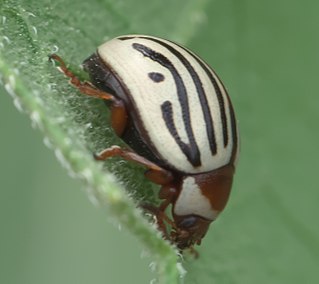
Zygogramma exclamationis, commonly known as the sunflower beetle, is a species of leaf beetle belonging to the family Zygogramma. It is regarded as a pest of sunflower crops in North America.

Carpophilus lugubris, commonly known as the dusky sap beetle, is a species of beetle in the genus Carpophilus. It is an agricultural pest of corn and tomato.
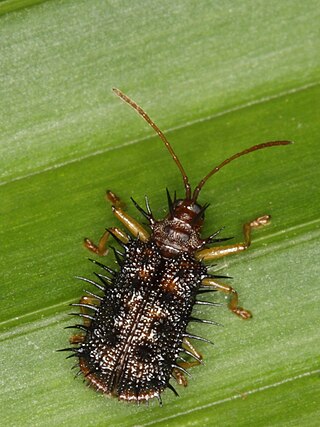
Dicladispa armigera is a species of leaf beetle from Southeast Asia, often known by its common name: the "rice hispa". These beetles are a well known invasive pest, and are responsible for significant crop damage across many countries. The male to female ratio is between 1:1.26 and 1:1.46.



















